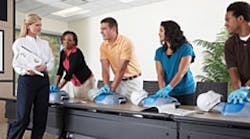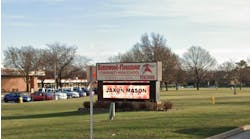On a Friday night in 2000, high school football player Josh Miller collapsed as he ran off the field. Several minutes later, the 15-year-old was dead from sudden cardiac arrest (SCA). This is not an uncommon scenario in school athletics. According to the American Heart Association (AHA), SCA is the leading cause of death in young athletes and Americans in general; it claims more than 250,000 lives annually. Statistics from the American Association of School Administrators indicate that 7,000 to 10,000 young people die each year from sudden cardiac arrest.
In June 2008, U.S. News and World Report published the results of a study from HeartRhythm Journal that found that students who suffer from SCA have only a one in 10 chance of survival. Of the cases that occurred from 2000 to 2006, the overall survival rate was 11 percent, ranging from 4 percent to 21 percent per year. A majority of these incidents occurred somewhere on school property.
As schools consider the issue of SCA, they should recognize that it is an important issue not only for student athletes, but also for community members. About 20 percent of a community's population is at a local school on any given day, whether it be to drop off something for a child, attend a social function or volunteer.
When someone experiences SCA, the time for response is short. The AHA advises the optimum time for reviving individuals suffering from SCA is within three minutes of the incident. When a person has immediate access to automatic external defibrillators (AEDs), these survival rates increase by as much as 80 percent. This rate drops to 2 percent for individuals left untreated after 10 minutes.
The argument for AEDs
Local emergency-response teams are equipped with AEDs and generally are very efficient, but a number of factors can prevent a timely response. For instance, an emergency squad might be at another call, encounter traffic on the way to the school or have to climb several flights of stairs in order to find the individual. This valuable time can mean the difference between life and death.
To help increase the chance of survival for individuals who experience SCA, more schools have installed AEDs. Several states are debating whether to mandate AEDs in schools; still, many institutions do not have the devices. Facility managers can better protect the health and safety of building occupants by acquiring AEDs. In addition, they can play an important role in helping determine which AED might be best for their facility.
Some school decisionmakers have come to believe if an AED is deployed improperly, the school will be held liable in a legal suit. As a result, many schools are reluctant to acquire an AED. But recent court decisions and Good Samaritan laws have established that in most situations, an individual who attempts to resuscitate an individual with SCA, or the facility in which the incident occurred, will not be liable. Good Samaritan laws are intended to reduce bystanders' hesitation to assist for fear of being sued or prosecuted for unintentional injury or wrongful death. Based on recent court decisions, facilities without an AED may have greater liability exposure than those that have an AED onsite.
Establishing an AED program
Buying AEDs is the first step to developing an AED program. AEDs should be accompanied by a comprehensive training and maintenance program to ensure the unit is always ready for use. Some considerations:
-
The unit: Most AED systems offer voice-activated prompts that guide a user. Once a unit is turned on, the user is instructed to place the two pads on the patient's chest. The pads analyze the patient's cardiac activity and determine whether or not defibrillation or shock treatment is needed. If a shock is needed, the light on the AED flashes, and the user is instructed to press the shock button. The pads deliver an electrical current, which is delivered once the button is pressed; the user then is instructed to begin CPR. The AED counts out the exact amount of time for CPR to be conducted and then reassesses the individual. In a majority of cases where the patient has been saved, it usually is the first shock that re-establishes the individual's normal heart rhythm.
-
Training: Key school personnel such as security staff, administrators, coaches and trainers generally are the first to be alerted when an SCA incident occurs, so they should be trained to use AEDs properly. This training should be part of a comprehensive AED program that specifies how personnel should respond and how the AEDs should be maintained.
Once key personnel are trained, all school employees should be made aware of the new program and the steps that should be taken if an SCA event occurs. This communication also should include the chain of survival: early access (calling for help and providing emergency medical services), early CPR, early defibrillation and early advanced care.
-
Maintenance: To ensure units are kept in working order, many schools use AED suppliers that offer online maintenance programs. After a school buys AEDs, representatives from the company work directly with the school and develop online programs that simplify the process of maintaining the unit, updating training records and tracking when its components should be replaced.
Location, location, location
Once a school has AEDs, it needs to decide where the units should be situated. The AHA specifies that AEDs should be placed in areas where they can be deployed within three minutes. In order to decide an optimal location, facility managers and administrators should identify key locations within the building where an SCA incident is most likely to occur. For instance, large rooms used to host events such as auditoriums, gymnasiums and cafeterias are good locations for AEDs. In addition, main corridors linking these areas also might be a target location.
In a school, units should be kept in an unlocked, alarmed cabinet that sounds when it is accessed. Locked areas such as a nurse's office are not ideal locations. If AEDs are not accessible within the first three minutes that an incident occurs, the individual's chance of survival is reduced greatly.
AEDs also should be accessible during outdoor athletic events such as football and soccer games, cross-country and track meets, and practices. This can be part of an emergency-response bag that includes emergency oxygen, an AED, a first-aid kit and trauma equipment. Coaches and athletic trainers should be ready to deploy an AED if necessary.
Protecting the masses
Facility managers at schools should make staff aware of how to identify an individual with SCA, where units are situated and who to contact if an AED needs to be deployed. At schools without AEDs, facility managers should encourage administrators and other key personnel to review the statistics associated with student SCA and the importance of AEDs in reducing deaths associated with SCA.
Schools are epicenters of the community. AEDs are situated throughout many other community facilities such as grocery stores and exercise centers, but many schools are not equipped. With the new information relating to the risks associated with SCA in schools, now is the time to take action. Grant programs are making it possible for schools to secure funding for AEDs.
An AED program lets parents, administrators, students and community members know that schools have the technology that can save lives.
Do you have AEDs at your institution or wish you did? If so, comment on this article or at Schoolhouse Beat: The Blog.
Bingham is Director of AEDs and Training for Cintas' First Aid & Safety division, Cincinnati. He can be reached at [email protected] or (800)246-8271.



